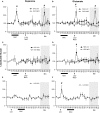Post-learning molecular reactivation underlies taste memory consolidation
- PMID: 21991247
- PMCID: PMC3181436
- DOI: 10.3389/fnsys.2011.00079
Post-learning molecular reactivation underlies taste memory consolidation
Abstract
It is considered that memory consolidation is a progressive process that requires post-trial stabilization of the information. In this regard, it has been speculated that waves of receptors activation, expression of immediate early genes, and replenishment of receptor subunit pools occur to induce functional or morphological changes to maintain the information for longer periods. In this paper, we will review data related to neuronal changes in the post-acquisition stage of taste aversion learning that could be involved in further stabilization of the memory trace. In order to achieve such stabilization, evidence suggests that the functional integrity of the insular cortex (IC) and the amygdala (AMY) is required. Particularly the increase of extracellular levels of glutamate and activation of N-methyl-d-aspartate (NMDA) receptors within the IC shows a main role in the consolidation process. Additionally the modulatory actions of the dopaminergic system in the IC appear to be involved in the mechanisms that lead to taste aversion memory consolidation through the activation of pathways related to enhancement of protein synthesis such as the Protein Kinase A pathway. In summary, we suggest that post-acquisition molecular and neuronal changes underlying memory consolidation are dependent on the interactions between the AMY and the IC.
Keywords: conditioned taste aversion; dopamine; glutamate; memory consolidation; molecular reactivation.
Figures



References
LinkOut - more resources
Full Text Sources

